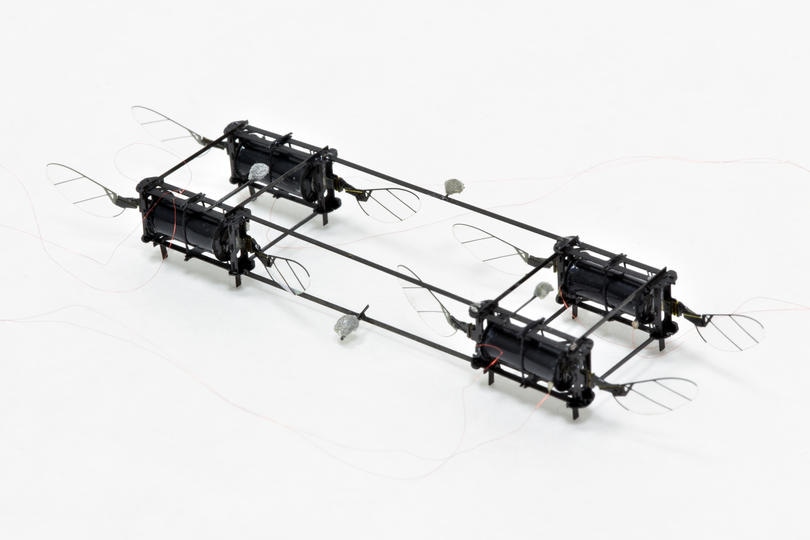Nov 5 2019
A RoboBee rushing toward a wall or bumping into a glass box might have caused panic earlier among scientists at the Harvard Microrobotics Laboratory at the Harvard John A. Paulson School of Engineering and Applied Science (SEAS). However, that is not the case anymore.
 A four-actuator, eight-wing soft RoboBee (Image credit: The Harvard MicroRobotics Lab/Harvard SEAS)
A four-actuator, eight-wing soft RoboBee (Image credit: The Harvard MicroRobotics Lab/Harvard SEAS)
Scientists from SEAS and the Wyss Institute for Biologically Inspired Engineering have created a strong RoboBee driven by soft artificial muscles with the ability to fall onto the floor, crash into walls, and bump into other RoboBees without any damage. It is the first microrobot powered by soft actuators to realize controlled flight.
There has been a big push in the field of microrobotics to make mobile robots out of soft actuators because they are so resilient. However, many people in the field have been skeptical that they could be used for flying robots because the power density of those actuators simply hasn’t been high enough and they are notoriously difficult to control. Our actuator has high enough power density and controllability to achieve hovering flight.
Yufeng Chen, Study First Author and Postdoctoral Fellow, Harvard SEAS
Chen is a former graduate student of SEAS. The study has been reported in Nature.
To find a solution to this power density problem, the scientists built upon the electrically powered soft actuators created in the lab of David Clarke, the Extended Tarr Family Professor of Materials. These soft actuators are developed with dielectric elastomers, which are soft materials with better insulating properties and deform upon applying an electric field.
The scientists could operate the actuator at 500 Hz by optimizing the electrode conductivity, comparable to the rigid actuators used earlier in analogous robots.
Another difficulty faced while using soft actuators is that the system shows a tendency to get buckled and turn unstable. The researchers overcame this by developing a lightweight airframe including a piece of vertical constraining thread to inhibit buckling of the actuator.
It is possible to easily assemble and replace the soft actuators in these small-scale robots. The researchers demonstrated different flight capabilities by developing various different models of the soft-powered RoboBee.
A two-wing model was able to take off from the ground, but did not have additional control. A four-wing, two-actuator model was able to fly in a chaotic environment, overcoming several collisions in a single flight.
One advantage of small-scale, low-mass robots is their resilience to external impacts. The soft actuator provides an additional benefit because it can absorb impact better than traditional actuation strategies. This would come in handy in potential applications such as flying through rubble for search and rescue missions.
Elizabeth Farrell Helbling, Study Co-Author and Former Graduate Student, Harvard SEAS
A model with eight wings and four actuators exhibited controlled hovering flight, which was the first for a soft-powered flying microrobot. The next goal of the researchers is to improve the soft-powered robot’s efficiency, which is still far behind that of a number of conventional flying robots.
Soft actuators with muscle-like properties and electrical activation represent a grand challenge in robotics. If we could engineer high performance artificial muscles, the sky is the limit for what robots we could build.
Robert Wood, Study Senior Author and Charles River Professor of Engineering and Applied Sciences, Harvard SEAS
Wood is also a core faculty member of the Wyss Institute for Biologically Inspired Engineering.
The intellectual property relating to this project is protected by Harvard’s Office of Technology Development, which is now seeking opportunities for commercializing the RoboBee.
The study was co-authored by Huichan Zhao, Jie Mao, Pakpong Chirarattananon, Nak-seung, Patrick Hyun, and David Clarke. The National Science Foundation partially supported the study.
RoboBee powered by soft muscles
(Video credit: Harvard SEAS)